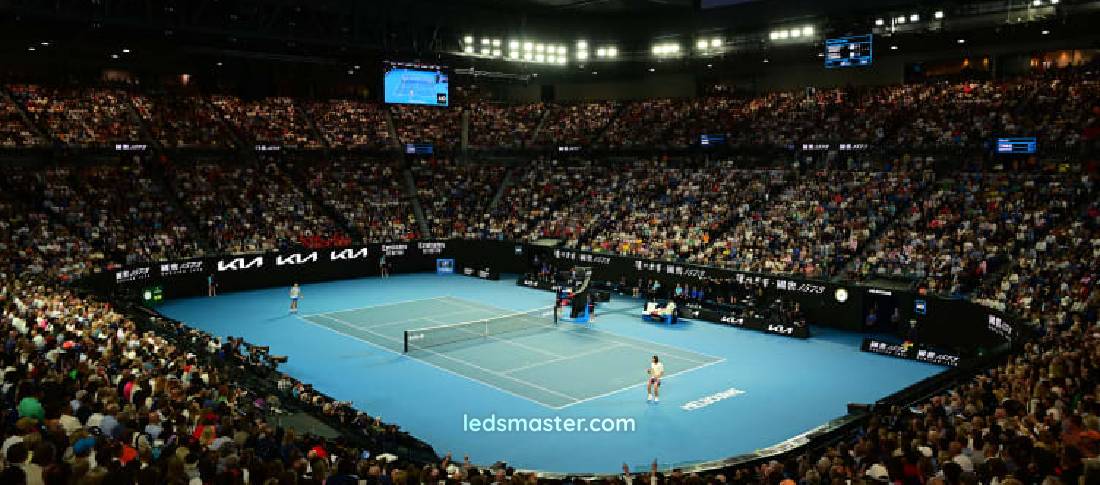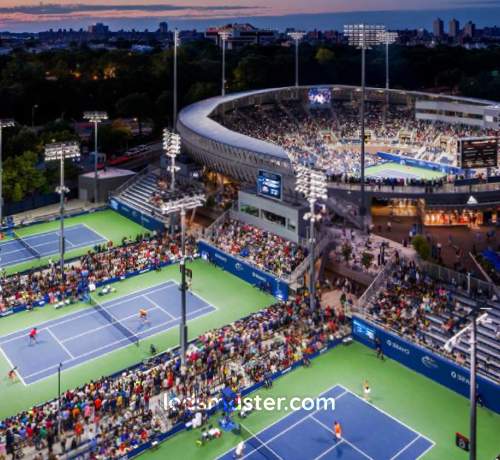Designed for energy efficiency and optimal visibility, our solar lights provide a sustainable and cost-effective way to enhance the playing experience. Discover a variety of options tailored to meet your facility’s needs and enjoy a brighter, eco-friendly environment for every match!
Get your complimentary lighting design today
Illuminate your tennis courts with innovative solar lighting solutions! Our high-quality, energy-efficient solar lights enhance visibility and safety for players and spectators alike. Harnessing the power of the sun, these lights ensure sustainable performance while reducing energy costs. Explore a range of options designed to meet the unique needs of your facility and create an inviting environment for every match.
As sports facilities evolve to meet modern needs, the technology supporting these environments adapts as well, enhancing both functionality and user experience. One of the most significant developments in sports facility lighting has been the shift toward solar lighting, particularly for outdoor courts like tennis courts. Solar tennis court lighting presents a sustainable, cost-effective, and practical solution for sports clubs and recreation centers aiming to reduce their energy expenditure while providing a well-lit, safe, and enjoyable environment for players and spectators.
This comprehensive guide explores the many dimensions of solar lighting for tennis courts, including its key benefits, the types of solar lighting available, important installation considerations, performance factors, and the role of battery life and energy efficiency in achieving long-term functionality.
Table of Contents
ToggleOne of the primary reasons facilities invest in solar lighting for tennis courts is the significant reduction in energy costs. Traditional lighting systems that draw power from the grid can quickly become a financial burden for facilities, especially those that host evening matches or community events that require prolonged illumination. By harnessing the sun’s energy, solar lighting drastically lowers electricity bills, making it a particularly appealing choice for facilities looking to balance performance with budget-conscious solutions.
Solar lighting also contributes to a facility’s sustainability goals, reducing reliance on fossil fuels and minimizing the carbon footprint associated with traditional energy sources. By choosing solar-powered lighting, sports facilities actively support global green initiatives, aligning with the broader environmental goals of many modern communities. Solar lighting also offers a reliable option for sports complexes in remote or off-grid areas, enabling more widespread access to quality sporting experiences.

Compared to traditional lighting systems, solar lights are relatively low-maintenance. They feature fewer components that require regular servicing, which reduces the cost and effort involved in keeping them operational. Many high-quality solar lights are also engineered to withstand extreme weather conditions, including high winds, heavy rains, and temperature fluctuations. This durability not only ensures a longer lifespan for the lighting system but also provides consistent performance, even under challenging conditions. Facility managers find this aspect of solar lighting particularly appealing, as it reduces both labor and repair costs over the system’s lifecycle.
Beyond cost savings and sustainability, solar lighting significantly improves the safety and visibility of tennis courts, especially during evening hours. Well-lit courts are essential for player safety, as they allow participants to see the ball clearly, accurately judge distances, and move safely around the court. Quality solar lighting systems enhance the visibility of the playing area, creating a safer and more enjoyable experience for players, coaches, officials, and spectators. In this way, solar lighting not only meets but often exceeds the functional needs of tennis courts, providing high-quality illumination that rivals traditional lighting solutions.
Solar flood lights are among the most popular options for illuminating tennis courts, offering a wide beam angle and substantial brightness to cover large outdoor areas. These lights are particularly effective for sports settings due to their broad illumination, which ensures that the entire playing area remains well-lit, minimizing shadows and dark spots. Many solar flood lights are also adjustable, allowing facility managers to direct light where it’s most needed or adjust brightness settings based on specific match or event requirements. This adaptability makes solar flood lights a versatile solution, especially for facilities that host diverse activities.
LED lights are a natural choice for solar lighting systems due to their energy efficiency and long lifespan. LEDs consume less energy while providing high lumens per watt, making them ideal for sporting environments that require high levels of illumination. Furthermore, LED lights are known for their durability and can last up to 25,000 hours, reducing the need for frequent replacements. By integrating LED lights into a solar system, facilities not only maximize energy efficiency but also ensure a consistent level of brightness, enhancing the overall experience for both players and spectators.
Motion sensor lights are an innovative addition to solar lighting systems, designed to activate only when movement is detected. This feature is particularly beneficial for facilities that don’t require constant lighting throughout the night, such as courts used for evening practice or occasional matches. Motion sensor lights help conserve energy during periods of inactivity, extending battery life and reducing the system’s overall power consumption. For facilities that need lighting only during specific hours, motion sensor technology represents a smart and efficient solution that aligns with energy-saving goals.
 Effective installation of solar lighting requires a thorough assessment of the site layout and positioning of each fixture. Before installation, facility managers should carefully evaluate the orientation of the court, any potential obstructions (such as trees, buildings, or walls), and the amount of direct sunlight each area receives throughout the day. Solar panels need adequate sun exposure to charge efficiently, so selecting locations with minimal shade is essential to ensure consistent energy generation.
Effective installation of solar lighting requires a thorough assessment of the site layout and positioning of each fixture. Before installation, facility managers should carefully evaluate the orientation of the court, any potential obstructions (such as trees, buildings, or walls), and the amount of direct sunlight each area receives throughout the day. Solar panels need adequate sun exposure to charge efficiently, so selecting locations with minimal shade is essential to ensure consistent energy generation.
Understanding the court’s layout also helps determine where lights should be positioned for optimal illumination. Courts often require lights on all four corners or along the perimeter to achieve an even distribution of light across the playing surface. Strategic placement prevents dark spots and reduces glare, enhancing the court’s visibility and improving the quality of play.
The type of solar lighting system chosen also impacts installation procedures. Some solar lights come with integrated solar panels, while others require separate panel mounting, often at a higher location to capture maximum sunlight. Facilities should account for the necessary infrastructure, such as poles or brackets, to mount the lights and ensure they are positioned securely. Additionally, installers should confirm that any poles or fixtures comply with local safety standards and regulations, which may require permits or inspections.
Professional installation is often recommended to ensure the system operates optimally. Certified installers can ensure that each component is correctly positioned and securely anchored, minimizing the risk of damage or underperformance due to improper setup. By investing in a professional installation, facilities can enhance the longevity and efficiency of their solar lighting systems, maximizing the value of their investment.
Brightness is a key factor in the effectiveness of tennis court lighting. Adequate illumination levels help players see the ball clearly, make accurate decisions, and maintain high performance. For recreational tennis, a minimum illumination level of 300 lux is recommended, while competitive matches often require a brightness level of 500 lux or higher. Solar lighting systems designed for tennis courts should be capable of meeting these standards to ensure that the entire playing surface is evenly lit, creating a safe and comfortable environment for players.
To achieve optimal performance, solar lights for tennis courts should feature high-quality LED bulbs capable of producing the required lux levels without excessive energy consumption. LEDs also come in various color temperatures, typically measured in Kelvin (K). A cooler white light, around 5000K, is often preferred for sports settings, as it closely resembles daylight, providing a natural and comfortable environment for players. Additionally, cooler color temperatures help enhance contrast, making it easier for players to track the ball and improving the overall gameplay experience.
Strategic layout is crucial to ensuring even light distribution across the entire court. Lights should be arranged in a way that prevents glare, as glare can disrupt players’ focus and potentially lead to safety issues. Placing lights at a height and angle that minimizes direct exposure to players’ eyes enhances both performance and safety. Proper layout planning also avoids areas of excessive brightness or shadow, which can compromise the quality of play. By optimizing the light layout, facilities can ensure a seamless and enjoyable experience for athletes and spectators alike.
Battery quality is a critical component in the effectiveness and longevity of solar lighting systems. Batteries store the energy collected during the day and supply it to the lights at night. High-quality lithium-ion batteries are commonly used in solar lighting due to their long lifespan, reliability, and resistance to temperature variations. Lithium-ion batteries can provide extended usage periods without the need for frequent replacements, making them a cost-effective and durable choice for outdoor applications.
Many advanced solar lighting systems incorporate smart technology to optimize battery efficiency. Smart controllers can adjust lighting levels based on ambient conditions or occupancy, automatically dimming the lights during low-usage periods to conserve energy. This type of intelligent energy management helps extend battery life and ensures the lights remain functional even during cloudy or low-sunlight periods. For facilities with variable activity schedules, these smart systems offer a balanced solution that supports both performance and energy savings.
The capacity of the battery must also be sufficient to handle extended periods of low sunlight, such as during rainy or overcast weather. Batteries with a larger capacity can store more energy, allowing the lighting system to continue operating without interruption, even when sunlight is limited. This feature is particularly valuable for facilities in regions with variable weather patterns, ensuring the court remains lit and accessible regardless of external conditions.
Solar tennis court lighting represents a forward-thinking solution that blends performance with sustainability. By exploring the benefits, types of lighting available, installation considerations, brightness standards, and battery efficiency, facility managers can make well-informed decisions that enhance both the functionality and environmental responsibility of their courts.
As solar technology continues to advance, solar lighting will play an increasingly central role in sports facility management, offering an alternative that balances economic and ecological benefits. For sports facilities, adopting solar lighting is more than just a technological upgrade—it is a commitment to sustainability and a greener future. This innovative approach not only supports a better sporting environment but also aligns with the growing emphasis on green initiatives in today’s world, ultimately setting a new standard for modern sports infrastructure.